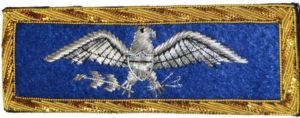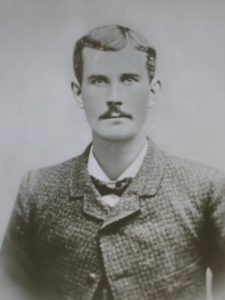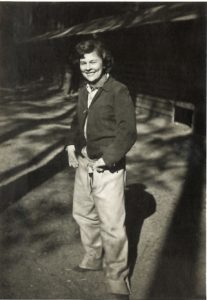I called my friend Spade yesterday evening. He picked up on the first ring.
“Hey, doll, what’s cooking? Have you found one of my cousins who will Y-DNA test?” I could hear ice clinking in a glass. He was no doubt having some Cutty Sark to celebrate yet another successful case in which he dug up someone’s long-dead relative.
Spade has a Rankin line with a solid paper trail back to Adam and Mary Steele Alexander Rankin. But we all want Y-DNA confirmation. He supplied the names of a half-dozen Rankin men in his line — his distant cousins. My job was to recruit just one to Y-DNA test. I failed miserably.
“No. Your cousins are a frustrating lot. I wrote to four or five of them but received no replies. But never mind them. My beef is with you, Spade.”
He sighed, and I clearly detected the sound of a generous splash into a glass. “Now what have I done?” Spade is definitely not the long-suffering type, but he can play that role on occasion.
“I was looking at your otherwise excellent online tree and found a SAR application you included as evidence for one Rankin family. It has a terrible error which is a zombie that won’t die. I’m holding you partly responsible for its survival because you are publishing that thing.”
There was a momentary silence. I knew it wouldn’t take him long to demur, so I wasn’t holding my breath.
“I know the one you mean. Yep, it does contain an egregious error. But I like to attach all relevant evidence, even if it’s partly wrong.”
Now the momentary silence was on my end of the line. “Well,” I finally said, “that’s an interesting notion. But how are people supposed to know which parts of the evidence are correct and which parts are error?”
“Because I file an explanatory comment explaining what’s what,” he quickly rejoined.
I thought I detected slurping. I didn’t know anyone slurped Cutty. This conversation was clearly heading downhill quickly.
“That’s helpful, but what if people don’t read your comment? I, for one, missed it altogether.”
Another slurp. He ignored my first question. “You missed it because I haven’t written a comment yet. Why don’t you post an exposé on your blog?”
With that, he hung up. Spade is famous for hanging up on people.[2]
* * * * * * * *
Spade left me no choice. As it turns out, there is no way for him to comment on that accursed SAR application. So here is my exposé. Don Quixote would be proud.
I am going to quote the SAR application, putting the crummy information in boldface with a comment clearly indicating error.
The SAR application in question was by WILLIAM STEWART RENKIN,[3] whose great-great-great grandfather was, according to the application, a member of the Westmoreland County, Pennsylvania militia during the Sandusky Expedition in 1782. That was an engagement on the western front and one of the last operations in the Revolutionary War.[4]
William Stewart died in 1967, but I communicated with his daughter[5] for several years. She has since died as well. Her father did the initial family history research for their Renkins and prepared the SAR application. She diligently supplemented his work with excellent, thorough research of her own. I enjoyed arguing with her.
Unfortunately, the information on her father’s SAR application has one flaw — and the flaw is not even relevant to his claim to SAR membership! Put another way, the error wasn’t needed to establish whether William Stewart was eligible. He could have omitted two generations and his application would have been perfectly fine.
The bad information in that SAR application has, of course, multiplied like Tribbles on the starship “Enterprise” in the original Star Trek. The error is included in countless online trees.
We have ALL made research errors, so I am not being critical of William Stewart’s work. I do confess to an occasional eye-roll when people accept assertions on Find-a-Grave, SAR applications, and online trees despite lack of evidence. Or, worse yet, without verifying the assertions for themselves.
Here is what the application says. My comments are in either italics or boldface.
William Stewart Renkin, born on June 16, 1913, was:
(1) the son of William Oran Renkin, 1875-1943, and Jane Fulton Stewart.
(2) the grandson of William Wilson Renkin, 1842-1922, and Sarah Hefron Hunter.
(3) the great-grandson of William Johnson Rankin, 1813-after 1870, and Nancy Johnson Anthony.
(4) the great-great-grandson of William Jackson Rankin, 1788-1870, and his first wife Margaret McHargus Ramsey.
(5) the great-great-great-grandson of William Rankin Jr, 1743-1823, and his wife Jane Taylor. “Jr.” is handwritten on the application, although William never used that designation SFAIK. His most likely death date is 1826 rather than 1823. This is the man whose service was the basis of the SAR application. He died in Indiana County and left a will dated 1822, proved 1826.[6]
(6) the great-great-great-great-grandson of William Rankin, died 1798, and Mary Huston. THIS IS WRONG: the William Rankin who died in Indiana County in 1826 was NOT a son of William and Mary Huston Rankin. That couple did have a son named William, but records (see discussion below) conclusively prove he moved to Centre County, Pennsylvania, and died there in 1847. He cannot possibly have been the same man as the William Rankin who died two decades earlier in Indiana County. Also, the William Rankin who married Mary Huston died in 1792 rather than 1798.
(7) the great-great-great-great-great-grandson of Adam Rankin died 1750 and his “2d wife Mrs. Mary Steele.” Adam died in 1747 rather than 1750. There is apparently no evidence in the records for a first wife. That is an assertion in the oral history of two genetically unrelated families, one of whom claims descent from the Adam who died in 1747 in Lancaster County. The other claims descent from John Rankin who died in Lancaster in 1749. Y-DNA testing proves those families are not related through the paternal Rankin line. Given the error in item (6), it follows that William Stewart Renkin was not descended from Adam and Mary Steele Alexander Rankin. Big Y testing confirms that.
Below is the evidence concerning William, son of William and Mary Huston Rankin. It is yet another example of what I call the “follow the land theory.” That is a solid form of genealogical proof if you want to be certain, for example, that the William you are following around was the same man as William, son of Adam and Mary Steele Alexander Rankin.
Let’s start with a will. Specifically, the will of William Rankin of Franklin County whose wife was Mary Huston.[7] We are concerned with two provisions, those dealing with land devised to four of their sons:
- Sons James and William jointly received 900 acres in Penns Valley, Mifflin County.
- Sons John and Jeremiah jointly received 408 acres on Spring Creek in Penns Valley, Mifflin County.
Now let’s check out Mifflin County, Penns Valley, and Spring Creek to make sure we know where these two inherited tracts wound up.
… “Penns Valley” is located in southeastern Centre County and includes Potter Township, which appears often in the records for these men.
… A “Spring Creek” runs through the middle of Bellefonte, the county seat of Centre County.[8]
… Centre County was created in 1800 from parts of four counties, including Mifflin.
We therefore know that the two tracts William devised to four of his sons were located in what is now Centre County. John and Jeremiah should be located close to each other, since they jointly inherited one tract. James and William should also be located near each other for the same reason.
Voila! There they are, all four brothers in Centre County, paired off geographically just as one would expect. In the 1800 Pennsylvania Septicentennial Census for Potter Township, James and William are entries #150 and #151, respectively, indicating they were surveyed sequentially and thus lived adjacent to each other. John and Jeremiah did not appear in that census, and may have still been home in Franklin County.
In the 1810 census for Potter Township, James Rankin is listed two households down from William Rankin.[9] The prior page for Potter Township has listings for Jeremiah and John, a dozen households apart.[10] All four men were enumerated in the age 26 < 45 category, so they were born during 1765–1784. The family Bible establishes the birth dates of the four men as follows: William, 1770, James, 1776, John, 1779, and Jeremiah, 1783.[11] Fits like a glove! Finally, Centre County cemetery records show John Rankin’s birth year as 1778 (off by one year, a common error since the deceased wasn’t there to provide a correction, or possibly a typo or misread by the abstractor) and Jeremiah’s as 1783 (correct).[12]
There is just no reasonable doubt that the four Rankins in Centre County were sons of William and Mary Huston Rankin and grandsons of Adam and Mary Steele Alexander Rankin. There is also no reasonable doubt that William Rankin of Centre County, who died there in 1847, was a different man than the William Rankin who died in Indiana County in 1826 and who was William Stewart Renkin’s ancestor. As one would expect, a Y-DNA test by one of William Stewart’s grandsons confirms that, since his results don’t match those for descendants of Adam and Mary.
At the risk of piling on, here are excerpts from a county history published in 1883. It identifies James, John, Jeremiah and William as brothers who came to Centre County from Franklin County, home of William and Mary Huston Rankin.
First, the following from History of Centre and Clinton Counties:[13]
“Rankin, William, was born in Franklin County, Nov. 5, 1770. He removed to Centre County and settled upon a farm two miles west of Potter’s Mills.”
A footnote to the above adds that “James, John, and Jeremiah Rankin, brothers of William, came to Penn’s Valley” from Franklin County.
History continues about William’s brother John, with the correct birth date:
“Rankin, John, Esq., died at the residence of his son-in-law, John Irvin, in Penn’s valley, April 22, 1848, aged sixty-nine. He was born in Franklin County, May 1, 1779, and was an early settler in Penn’s valley …”
And that is all.
I am fairly sure I haven’t heard the last on this subject from Spade, though.
See you on down the road.
Robin
[1] “Sons of the American Revolution.” That organization is obviously the male equivalent of the DAR, although their due diligence was deficient in this case.
[2] For proof of Spade’s propensity to hang up, please see a fun post at https://digupdeadrelatives.com/2023/01/01/john-mcginley-rankin-too-many-have-lived/
[3] “Renkin” and “Rankin” are genetically equivalent. My Rankin cousin’s closest match at 37 markers is a man named Renkin.
[4] See, e.g., https://emergingrevolutionarywar.org/2018/09/04/the-crawford-campaign-1782-battle-on-the-sandusky/
[5] I hope I spelled Jeanne’s name correctly but am not certain.
[6] Indiana Co., PA Will Book 1: 140.
[7] Franklin Co., PA Will Book A-B: 256, will of William Rankin of Antrim Twp. dated 20 Oct 1792, proved 28 Nov 1792. Wife Mary. Sons Adam, Archibald, James, William, David, John, and Jeremiah. Daughter Betsy.
[8] See, e.g., https://bellefontechamber.org/attractions/fly-fishing#:~:text=Anglers%20enjoy%20the%20world%2Dclass,the%20historic%20borough%20its%20name.
[9] 1810 census for Potter Township, Centre Co., PA. https://www.ancestry.com/discoveryui-content/view/430206:7613
[10] Id.
[11] Birth dates are from the family Bible, a transcription of which (along with the cover letter from the Bible owner) are contained in electronic storage of Flossie Cloyd’s materials at the Tennessee State Library and Archives. She was the premier Rankin historian of the 20th century, although she did very little research herself except on her own line. For the most part, she assembled materials from a number of other Rankin researchers.
[12] Mary Belle Lontz, Tombstone Inscriptions of Centre County, Pennsylvania (1984).
[13] John Blair Linn, History of Centre and Clinton Counties, Pennsylvania (Louis H. Everts, 1883, reprinted Philadelphia: J. B. Lippincott & Co., 1975) 222-23 and footnote at 222.







